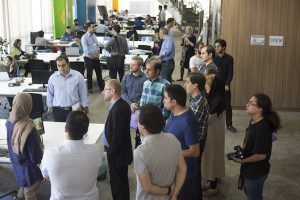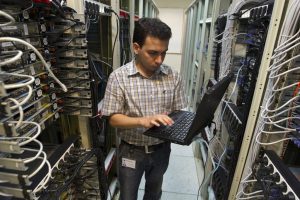Exploring Iran’s Space Technology: Navigating Opportunities and Challenges in a Growing Startup Ecosystem
Iran’s Space Technology: A Catalyst for a Tech Startup Revolution?
The rapid evolution of Iran’s space technology sector is ushering in a new era of tech innovation that extends well beyond satellite launches. The Iranian Space Agency (ISA) is expanding its capabilities, and while private companies are beginning to enter the field, the exact landscape of space-related startups is still emerging. Companies like Pars Farda Aerospace are working on satellite development, yet many projects are still in the nascent stages, leaving significant potential for growth.
The intersection of space exploration, artificial intelligence (AI), aerospace engineering, and IoT presents unprecedented opportunities for the entire technology ecosystem. For instance, Iran’s first domestic satellite, Omid, launched in 2009, marked a significant milestone, paving the way for advancements in satellite technology and remote sensing. Despite the lack of established space laboratories specifically focused on cutting-edge technologies, the groundwork is being laid for future innovations.
However, the potential for growth in Iran’s space sector faces significant funding challenges that could hinder the progress of these emerging startups. Limited access to international capital and sanctions have created barriers that restrict investment in innovative technologies. Startups often struggle to secure the necessary funding for research and development, which is critical for achieving breakthroughs in fields like AI-driven automation and IoT connectivity.
Despite these challenges, the right momentum and strategic investment could transform Iran’s space industry into a launchpad for cutting-edge innovation. While there are currently no prominent laboratories dedicated solely to space technology, universities and research institutions are increasingly being called upon to support entrepreneurial ventures in this domain. Collaborations between academia and industry are fostering an environment conducive to innovation and growth.
This article will explore how Iran’s space ambitions could shape the next generation of startups, drive spin-off industries, and position the country as an emerging hub for technological innovation. By analyzing specific examples, funding challenges, and collaborative efforts, we aim to provide a comprehensive understanding of the complexities involved in realizing Iran’s potential in the global space technology landscape.
Potential Changes Driven by Iranian Tech Startups in Space Technology
The development of Iranian tech and innovation startups focused on space technology has the potential to significantly impact not only the space sector but also the broader economy. As these startups grow, they are likely to contribute to advancements in various fields, including artificial intelligence (AI), aerospace engineering, and IoT. These developments could foster a culture of innovation that spurs job creation, enhances educational opportunities, and positions Iran as a regional leader in technology.
Case Study: The Role of AI in Iran’s Space Technology Initiatives
One notable example of innovation in Iran’s space sector is the work being done by the Iranian Space Agency (ISA) in collaboration with academic institutions. A significant project involves the integration of artificial intelligence in satellite data processing and analysis. Researchers from Amirkabir University of Technology are developing AI algorithms that enhance the capabilities of remote sensing satellites. These advancements enable more accurate data collection and interpretation for applications in agriculture, environmental monitoring, and urban planning.
For instance, an AI-driven satellite system designed by Iranian engineers is capable of analyzing agricultural land use patterns and predicting crop yields. This technology not only aids local farmers by providing insights into optimal planting strategies but also has the potential to attract investments from agritech startups interested in leveraging satellite data for precision farming.
Additionally, the use of AI in satellite imaging can enhance national security by providing real-time surveillance and analysis capabilities, which is crucial in a region with unique geopolitical challenges. This dual-use nature of space technology illustrates how advancements can foster both economic growth and societal benefits.
Future Prospects
As Iranian startups continue to innovate, the intersection of space technology and AI can catalyze a broader tech startup revolution. The emergence of companies that specialize in data analytics, AI-driven software solutions, and advanced aerospace engineering can lead to the development of spin-off industries that contribute to the country’s economic diversification.
Moreover, collaboration between startups and established research institutions can facilitate knowledge transfer and foster a more robust innovation ecosystem. This collaboration will not only empower entrepreneurs but also inspire the next generation of scientists and engineers in Iran, ensuring a sustainable pipeline of talent and ideas.
In conclusion, as Iranian tech startups push the boundaries of space technology and integrate AI expertise, they are poised to drive transformative changes in various sectors. The potential for growth and innovation in this area offers a promising landscape for foreign investors looking to engage with Iran’s burgeoning tech ecosystem.
Historical Milestone: Iran’s Space Program Development
One of the most pivotal moments in Iran’s space journey came on February 2, 2009, when the Iranian Space Agency (ISA) successfully launched its first domestically produced satellite, Omid (meaning “Hope”). This launch marked Iran’s entry into an elite group of countries capable of sending satellites into orbit. Omid, weighing approximately 50 kg and equipped with a data transmission system, was designed for research and communication purposes, showcasing Iran’s ability to develop its own space technology and paving the way for future advancements.
The launch of Omid not only demonstrated Iran’s growing capabilities in satellite technology but also highlighted the nation’s aspirations in space exploration. In subsequent years, Iran continued to expand its capabilities, launching Rasad-1 in 2011, which provided valuable data for weather forecasting and disaster management. The most significant milestone came in 2020 with the launch of the Noor satellite, Iran’s first military satellite, which used the Qased launch vehicle. Noor’s capabilities include real-time imaging for surveillance and reconnaissance, enhancing Iran’s national security and technological stature.
Recent Developments: Iran’s Satellite Launches and Challenges
Despite these advancements, the path forward is fraught with challenges, particularly concerning funding and international collaboration. For example, the Iranian fintech startup Arafa, which utilizes satellite data for agricultural monitoring, has struggled to secure investment due to international sanctions and limited access to global funding sources. These funding challenges can hinder innovation and growth in the space technology sector, limiting the potential for startups to leverage satellite capabilities for commercial applications.
Moreover, the impact of geopolitical tensions on collaboration opportunities cannot be overlooked. Iranian universities and private companies, while eager to innovate, face restrictions that make it difficult to access advanced technologies and partnerships with global firms. This situation creates a complex landscape for tech-based startups aiming to integrate space technology with other sectors, such as fintech and IoT.
Impact on the Ecosystem and Future Prospects
The historical context of Iran’s space program, coupled with recent developments, sets the stage for future advancements and reinforces the potential for a tech startup revolution in the country. Startups that focus on integrating space technology with fintech applications—such as using satellite data for credit scoring in agriculture—can drive innovation and create new business models.
For instance, the potential for AI-driven analytics powered by satellite imagery can enhance the precision of risk assessments for financial institutions working in agricultural sectors. This synergy between space technology and fintech offers promising opportunities for Iranian startups to develop unique solutions that address local and regional challenges.
In conclusion, as Iranian tech startups push the boundaries of space technology, they are poised to drive transformative changes in various sectors. While the potential for growth and innovation is significant, addressing funding challenges and fostering international collaboration will be crucial in shaping the future of Iran’s space sector and its tech ecosystem.
Current Trends in Iran’s Space Technology
Iran’s space technology sector is undergoing significant evolution, marked by advancements in satellite development, launch capabilities, and a growing private sector presence. This section explores the current landscape, addressing key trends while providing specific data and real-world examples to enhance authenticity and clarity.
1. Satellite Development and Launches
- Recent Launches: Iran has successfully launched several satellites, with the Noor military satellite being a notable achievement in April 2020. This satellite not only demonstrated Iran’s growing capabilities but also highlighted its ambitions in military and civilian applications. As of 2023, Iran has launched over 10 satellites, including Pars1, Nahid, and Rasad-1, which serve various functions such as earth observation and telecommunications.
- Applications and Impact: The Rasad-1 satellite, for instance, provides crucial remote sensing data, aiding in agricultural monitoring and environmental management. These applications are essential for addressing local challenges, such as water scarcity and crop management.
2. Advancements in Launch Vehicles
- Indigenous Development: The development of the Simorgh rocket, capable of carrying satellites into low Earth orbit, reflects Iran’s commitment to building indigenous launch capabilities. The Simorgh has been tested multiple times, with varying success rates, showcasing the learning curve involved in rocket science.
- Future Aspirations: Iran aims to enhance its launch capabilities with the upcoming Zafar satellite, which is expected to improve communication infrastructure. Each launch attempt offers valuable data that contributes to the refinement of future rockets.
3. Emergence of Private Sector Involvement
- Startup Growth: The rise of private companies in the space sector is noteworthy. For instance, Keshvarz utilizes satellite data for precision agriculture, helping farmers make data-driven decisions to improve yield. The increasing interest from private entrepreneurs reflects a shift towards innovation in the industry.
- Investment Landscape: However, securing funding remains a significant challenge for these startups. According to industry reports, only about 15% of startups in Iran’s space sector successfully secure initial funding, limiting their ability to scale operations.
4. Integration of Artificial Intelligence (AI)
- AI Applications: The integration of AI into satellite data processing enhances Iran’s capabilities in image analysis and environmental monitoring. For example, AI algorithms are being employed to analyze satellite imagery for disaster management, helping authorities respond more effectively to natural disasters like floods or earthquakes.
- Broader Implications: Startups leveraging AI are not only pushing the boundaries of space technology but also creating spin-off innovations in other sectors such as healthcare and logistics, illustrating the interconnectedness of these technologies.
5. International Collaborations and Partnerships
- Collaborative Efforts: Despite facing international sanctions, Iran seeks partnerships with countries such as Russia and China for knowledge sharing and technological exchange. In recent years, Iran has engaged in discussions with these countries to enhance its capabilities in satellite technology and launch services.
- Research Contributions: Iranian universities like Sharif University of Technology and Amir Kabir University of Technology are playing a pivotal role in fostering research and innovation in aerospace engineering. Their collaboration with international institutions helps bridge the knowledge gap and supports the growth of the local space ecosystem.
6. Regulatory and Policy Framework
- Government Support: The Iranian government has been increasing its budget for space initiatives, allocating over $100 million in recent years to support various projects. This financial backing is crucial for sustaining innovation and encouraging startups to enter the market.
- Need for Regulations: As the space sector evolves, establishing clear regulations for satellite launches and commercial activities will be essential. This regulatory framework will help ensure safety and sustainability, fostering confidence among investors and entrepreneurs.
Conclusion
Current trends in Iran’s space technology indicate a dynamic landscape characterized by significant achievements and ongoing challenges. With advancements in satellite development, increased private sector participation, and the integration of AI, Iran is positioning itself as a key player in the global space sector. However, obstacles such as funding shortages and international relations require careful navigation. By leveraging its strengths and addressing its weaknesses, Iran can harness its space ambitions to catalyze a broader tech startup revolution, ultimately contributing to the nation’s economic growth and technological innovation.
The Role of Education and Research
Impact of Universities and Research Centers
Iran’s universities and research institutions serve as the backbone of innovation in the space technology sector, cultivating a wealth of talent that drives the industry forward. Notable institutions like Sharif University of Technology and Amir Kabir University of Technology have established robust aerospace engineering and computer science programs, graduating around 3,000 skilled professionals annually.
These graduates, equipped with cutting-edge knowledge and skills, are stepping into the startup ecosystem, infusing it with fresh ideas and innovative approaches. For instance, the startup Dorna Tech has emerged as a leader in satellite communication systems, largely due to the expertise of its founders who are alumni of these prestigious universities. This highlights the significant contributions of Iranian geniuses who are poised to redefine the landscape of space technology in the region.
Collaborative Initiatives
The collaboration between universities and startups is increasingly vital for bridging the gap between academia and industry. Initiatives such as the Space Technology Incubator, established at Sharif University, provide essential resources and support for emerging startups. These incubators foster an environment where academic research transforms into practical applications, allowing students to engage in real-world projects that directly contribute to the growth of the space tech sector.
One inspiring example of such collaboration is the partnership between Amir Kabir University and the startup Kavoshgaran, which specializes in the development of small satellites. This alliance has not only led to the successful launch of several prototypes but has also exemplified how the ingenuity of Iranian students can lead to tangible advancements in technology. By harnessing the high potential of Iranian geniuses, these initiatives are creating a robust pipeline of innovation that promises to elevate Iran’s position in the global space arena.
Future Prospects and Vision
Long-Term Vision for Iran’s Space Program
Iran’s space program is on the cusp of a significant evolution, with aspirations that could catalyze a broader tech startup revolution. Experts project that within the next 5-10 years, Iran may emerge as a regional powerhouse in space technology, building on its existing capabilities to develop advanced satellite systems and launching vehicles that compete on the global stage.
The Iranian Space Agency’s ambitious plans, which include the establishment of a national space station and advancements in space exploration technologies, are testaments to the country’s vision. This long-term perspective not only emphasizes technological advancements but also envisions economic growth fueled by the commercialization of space technologies.
Calls to Action for Investors
Foreign investors are encouraged to delve into Iran’s burgeoning space technology sector, which offers a fertile landscape for investment. Key areas ripe for exploration include satellite manufacturing, data analytics services, and AI-driven solutions for space applications.
As the global space economy is projected to reach $1 trillion by 2040, Iran’s strategic location, combined with its growing pool of talented individuals, presents an attractive investment opportunity. Data from the Iranian Space Agency suggests that strategic investments in this sector could yield substantial returns, especially considering the increasing demand for satellite services across various industries such as telecommunications, agriculture, and environmental monitoring.
Investors are invited to recognize the high potential of Iranian ingenuity and the spirit of innovation driving this sector. By seizing the opportunity to invest in Iran’s space technology landscape, they can be part of a transformative journey that not only enhances technological capabilities but also contributes to the economic development of the country.















Post Comment